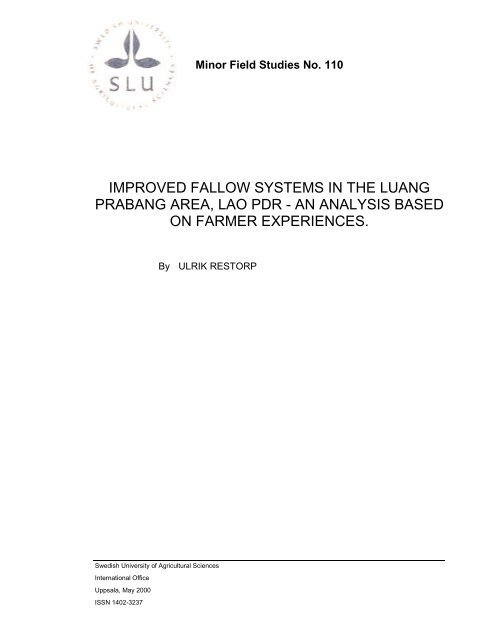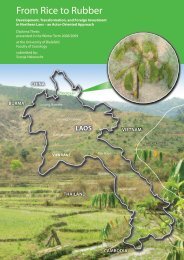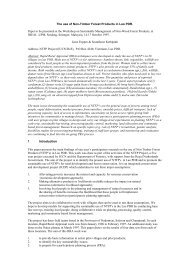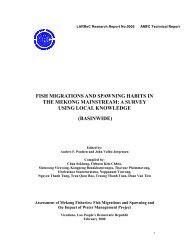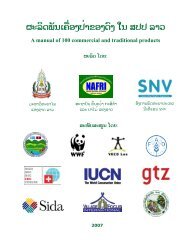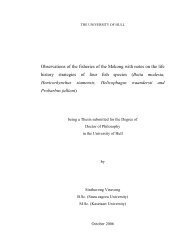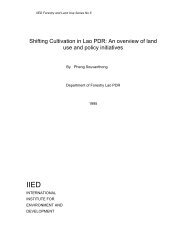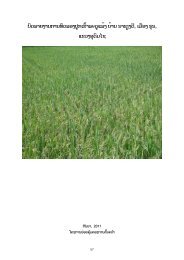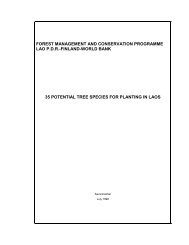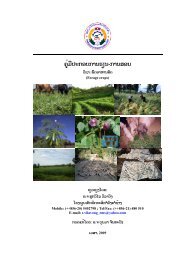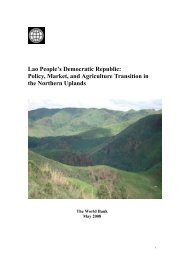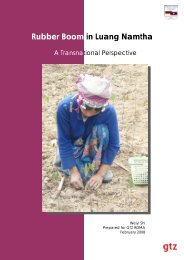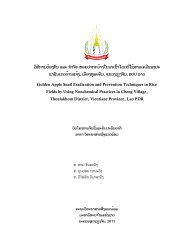improved fallow systems in the luang prabang area, lao pdr - Afaci
improved fallow systems in the luang prabang area, lao pdr - Afaci
improved fallow systems in the luang prabang area, lao pdr - Afaci
Create successful ePaper yourself
Turn your PDF publications into a flip-book with our unique Google optimized e-Paper software.
M<strong>in</strong>or Field Studies No. 110IMPROVED FALLOW SYSTEMS IN THE LUANGPRABANG AREA, LAO PDR - AN ANALYSIS BASEDON FARMER EXPERIENCES.ByULRIK RESTORPSwedish University of Agricultural SciencesInternational OfficeUppsala, May 2000ISSN 1402-3237
The M<strong>in</strong>or Field Studies series is published by <strong>the</strong> International Office of <strong>the</strong> Swedish Universityof Agricultural Sciences.M<strong>in</strong>or Field Studies are carried out with<strong>in</strong> <strong>the</strong> framework of <strong>the</strong> M<strong>in</strong>or Field Studies (MFS)Scholarship Programme, which is funded by <strong>the</strong> Swedish International Development CooperationAgency (Sida).The MFS Scholarship Programme offers Swedish university students an opportunity to undertaketwo months' field work <strong>in</strong> a develop<strong>in</strong>g country to be analysed, compiled and published as an <strong>in</strong>depthstudy or graduation <strong>the</strong>sis work. The studies are primarily made on subjects of importancefrom a development perspective and <strong>in</strong> a country supported by Swedish development assistance.The ma<strong>in</strong> purposes of <strong>the</strong> MFS programme are to <strong>in</strong>crease <strong>in</strong>terest <strong>in</strong> develop<strong>in</strong>g countries and toenhance Swedish university students' knowledge and understand<strong>in</strong>g of <strong>the</strong>se countries and <strong>the</strong>irproblems and opportunities. An MFS should provide <strong>the</strong> student with <strong>in</strong>itial experience ofconditions <strong>in</strong> such a country.The International Office of <strong>the</strong> Swedish University of Agricultural. Sciences adm<strong>in</strong>isters <strong>the</strong> MFSprogramme for <strong>the</strong> rural development and natural resources management sectors.The responsibility for <strong>the</strong> accuracy of <strong>in</strong>formation presented rests entirely with <strong>the</strong> respectiveauthor. The views expressed are those of <strong>the</strong> authors and not necessarily those of <strong>the</strong>International Office.Swedish University of Agricultural SciencesInternational OfficeBox 7070SE-750 07 UPPSALASwedenTelephone: +46 18 672309Fax: +46 18 673556E-mail:Monica.Hall<strong>in</strong>g@adm.slu.seTryck: SLU/Repro, Uppsala 2000IMPROVED FALLOW SYSTEMS IN THE LUANG PRABANG AREA, LAO PDR - AN ANALYSIS BASED ON FARMEREXPERIENCES.20040940 i
AbstractThis study is a follow-up of two earlier projects on <strong>improved</strong> <strong>fallow</strong> <strong>systems</strong> <strong>in</strong> shift<strong>in</strong>g cultivation<strong>area</strong>s of nor<strong>the</strong>rn Laos. Dur<strong>in</strong>g, <strong>the</strong>se projects legum<strong>in</strong>ous species such as Leucaenaleucocephala and Cajanus cajan were <strong>in</strong>troduced at experimentation plots on farm level, aim<strong>in</strong>gat quicker soil recovery dur<strong>in</strong>g <strong>the</strong> <strong>fallow</strong> period of <strong>the</strong> upland rice cropp<strong>in</strong>g cycle. Through<strong>in</strong>terviews with <strong>in</strong>volved farmers some conclusions on farmers' op<strong>in</strong>ions, performance of plot and<strong>improved</strong> <strong>fallow</strong> species could be drawn.In <strong>the</strong> farmers' op<strong>in</strong>ions plot performance is <strong>in</strong>creased by plantation of legum<strong>in</strong>ous species. andthis is to some extent supported by collected yield data. The best-suited species for <strong>improved</strong><strong>fallow</strong> is Leucaena leucocephala, as it can ma<strong>in</strong>ta<strong>in</strong> stable yields with higher land-pressure and itsurvives multiple cropp<strong>in</strong>g periods. The ma<strong>in</strong> threat to an extended use of <strong>the</strong> methods is <strong>the</strong>extra work to which <strong>the</strong> farmers are exposed at sow<strong>in</strong>g time, when <strong>the</strong> labour situation oftenalready is critical.Keywords: shift<strong>in</strong>g cultivation, <strong>improved</strong> <strong>fallow</strong>. agroforestry, LaosIMPROVED FALLOW SYSTEMS IN THE LUANG PRABANG AREA, LAO PDR - AN ANALYSIS BASED ONFARMER EXPERIENCES.ii20040940
AbbreviationsCTA Centre Technique de Cooperation Agricole et RuraleDoF Department of Forestry, VientianeFAO Food and Agricultural Organisation of <strong>the</strong> United NationsGPS Global Position<strong>in</strong>g SystemLSFP Lao-Swedish Forestry ProgrammeMFS M<strong>in</strong>or Field StudySCRP Shift<strong>in</strong>g Cultivation Research Project, Luang PrabangSida Swedish International Aid Co-operation AgencySUAS Swedish University of Agricultural SciencesUNDP United Nations Development ProgrammeIMPROVED FALLOW SYSTEMS IN THE LUANG PRABANG AREA, LAO PDR - AN ANALYSIS BASED ONFARMER EXPERIENCES.iii20040940
Improved <strong>fallow</strong> <strong>systems</strong> <strong>in</strong> <strong>the</strong> Luang Prabang <strong>area</strong>, Lao PDR – <strong>in</strong> analysis based on farmer experiencesForewordThis <strong>the</strong>sis for a Master's degree <strong>in</strong> Physical Geography is <strong>the</strong> result of a field study <strong>in</strong> Laosdur<strong>in</strong>g <strong>the</strong> fall of 1999. Earlier <strong>in</strong> 1999 I had contacted Mr Carl Mossberg, Senior Forestry Adviser<strong>in</strong> <strong>the</strong> LSFP, to get some ideas on a study <strong>in</strong> Laos. His quick and positive reply to my <strong>in</strong>quiriesmade <strong>the</strong> study possible.The supervisor <strong>in</strong> Laos was Mr Paul Overgoor, Agricultural Research Adviser <strong>in</strong> <strong>the</strong> SCRP. Healso outl<strong>in</strong>ed <strong>the</strong> ma<strong>in</strong> objectives of <strong>the</strong> study and is a pr<strong>in</strong>cipal source of <strong>in</strong>formation. I owe him alot for all <strong>the</strong> time and effort he put <strong>in</strong>to this work.The Swedish supervisor was Associated Professor Lars Franzen at <strong>the</strong> Department of PhysicalGeography, Göteborg University.Reviews of <strong>the</strong> draft versions of this report were made by PhD student Mira Ovuka and Dr BjornHolmer, both at <strong>the</strong> Department of Physical Geography. Their op<strong>in</strong>ions on <strong>the</strong> material werehighly valuable when f<strong>in</strong>alis<strong>in</strong>g <strong>the</strong> work.Work<strong>in</strong>g <strong>in</strong> <strong>the</strong> villages surround<strong>in</strong>g Luang Prabang and <strong>the</strong> Thong Khang research station wouldnot have been possible without <strong>the</strong> assistance of Mr Saysanna and Mr Prasith, both work<strong>in</strong>g <strong>in</strong><strong>the</strong> SCRP. The person who made <strong>the</strong> <strong>in</strong>terviews possible at all was Mr Bounma at DoF. Hefunctioned as a translator between Lao and English and as a fantastic guide to <strong>the</strong> customs ofLao villages. Last. but not least, I would like to thank <strong>the</strong> farmers of <strong>the</strong> Luang Prabang <strong>area</strong> for<strong>the</strong>ir warmth, hospitality and will<strong>in</strong>gness to spend <strong>the</strong>ir time on <strong>in</strong>terviews.The Sida M<strong>in</strong>or Field Study programme f<strong>in</strong>anced <strong>the</strong> study.IMPROVED FALLOW SYSTEMS IN THE LUANG PRABANG AREA, LAO PDR - AN ANALYSIS BASED ON FARMEREXPERIENCES.20040940 iv
Table of ContentsTable of ContentsIntroduction...................................................................................................1Lao People's Democratic Republic ............................................................................................1The Luang Prabang Area..........................................................................................................1Shift<strong>in</strong>g cultivation ..................................................................................................................2Concepts ................................................................................................................................2Shift<strong>in</strong>g cultivation <strong>in</strong> upland Laos.................................................................................................2Improved <strong>fallow</strong> ........................................................................................................................3Studied projects......................................................................................................................3The Shift<strong>in</strong>g Cultivation Research Project.......................................................................................3FAO/UNDP Program LA0/82/006 ................................................................................................4Study objective.........................................................................................................................4Methods........................................................................................................5The choice of villages ..............................................................................................................5Data collection........................................................................................................................6Interviews................................................................................................................................6Kalong....................................................................................................................................6Crop cuts ................................................................................................................................6Data analysis..........................................................................................................................7Separation of data.....................................................................................................................7Graph construction....................................................................................................................7Results.........................................................................................................8Implementation and adaptation .................................................................................................8Yield and <strong>fallow</strong>.......................................................................................................................8The effect of "bad" years..........................................................................................................9Improved and normal <strong>fallow</strong>......................................................................................................9Crop cuts ...............................................................................................................................9Change <strong>in</strong> <strong>fallow</strong> time ............................................................................................................10Yields of <strong>the</strong> study plots compared with <strong>area</strong> averages ..............................................................10Performance of different <strong>improved</strong> <strong>fallow</strong> species .....................................................................11Yields ..................................................................................................................................11Survival ...............................................................................................................................11Discussion..................................................................................................12Sources of errors ..................................................................................................................12Interpretation of <strong>the</strong> results ....................................................................................................12Too much work? .....................................................................................................................12Improved <strong>fallow</strong>?.....................................................................................................................13Preferred species....................................................................................................................13Conclusions................................................................................................15References..................................................................................................16IMPROVED FALLOW SYSTEMS IN THE LUANG PRABANG AREA, LAO PDR - AN ANALYSIS BASED ON FARMEREXPERIENCES.20040940 v
Table of ContentsList of FiguresFigure 1. Laos and surround<strong>in</strong>g countries.......................................................................................1Figure 2. Climatic data Luang Prabang Wea<strong>the</strong>r Station (305 m a.s.l.), average 1971-1990.......................1Figure 3. Rotational shift<strong>in</strong>g cultivation system with a three-year cycle. ................................................2Figure 4. Visited villages <strong>in</strong> <strong>the</strong> Luang Prabang <strong>area</strong>. (After maps E-47-12, E-47-24, E-48-1, E-48-13 ServiceGeographique D'Etat, scale 1:100000) ...................................................................................5Figure 5. The effect of "normal" and "bad" years on yields..................................................................9Figure 6. Yields after <strong>improved</strong> <strong>fallow</strong> compared with normal <strong>fallow</strong>......................................................9Figure 7. A verage rice yields from <strong>the</strong> crop cuts performed <strong>in</strong> section a, b and c. ...................................9Figure 8. Fallow time of <strong>the</strong> experiment plots before and after experiment implementation (all=SCRP+FAO/UNDP).....................................................................................................................................10Figure 9: SCRP study <strong>area</strong> average yields and <strong>improved</strong> <strong>fallow</strong> plot yields "good" and "bad" years. ..........10Figure 10. Yields of plots with different <strong>improved</strong> <strong>fallow</strong> species (leuc.=Leucaena, p.p.=Pigeon pea). ........11Figure 11: Survival of different <strong>fallow</strong> species after repeated cropp<strong>in</strong>g cycles........................................11Figure 12: Same as figure 6, but presented as bars with confidence <strong>in</strong>terval. .......................................12Figure 13: Same as figure 7, presented as bars with confidence <strong>in</strong>terval. ............................................12List of TablesTable 1. Outl<strong>in</strong>e of <strong>the</strong> question succession. ...................................................................................6IMPROVED FALLOW SYSTEMS IN THE LUANG PRABANG AREA, LAO PDR - AN ANALYSIS BASED ON FARMEREXPERIENCES.20040940 vi
Improved <strong>fallow</strong> <strong>systems</strong> <strong>in</strong> <strong>the</strong> Luang Prabang <strong>area</strong>, Lao PDR – an analysis based on farmer experiencesIntroductionIntroductionLao People's Democratic RepublicLao PDR or Laos, is landlocked country with a total<strong>area</strong> of 237,000 km 2 and 4.8 million residents (Sida1996). The <strong>in</strong>come per capita is among <strong>the</strong> lowest <strong>in</strong><strong>the</strong> world and aviculture is <strong>the</strong> most importanteconomic sector. It <strong>the</strong> ma<strong>in</strong> source of <strong>in</strong>come forabout 85 % of <strong>the</strong> labour three and more than 80% of<strong>the</strong> cultivated <strong>area</strong> is devoted to <strong>the</strong> ma<strong>in</strong> staple food,rice (Saphangthong 1998).About 75%) of Laos is hilly to mounta<strong>in</strong>ous withaltitudes Tam<strong>in</strong>g from 1000 to 2000 m. The restconsists of lowland, alluvial pla<strong>in</strong>s and terraces near<strong>the</strong> Mekong, River (Souvanthong 1994.). Monsoonforests and upland cropp<strong>in</strong>g cover <strong>the</strong> hills andmounta<strong>in</strong>s, while <strong>the</strong> lowlands ma<strong>in</strong>ly are used <strong>in</strong> wetrice production.••The Luang Prabang AreaFigure 1. Laos and surround<strong>in</strong>g countries.Luang Prabang City lies by <strong>the</strong> Mekong River <strong>in</strong> <strong>the</strong> nor<strong>the</strong>rn part of <strong>the</strong> country (Figure 1). Thesurround<strong>in</strong>gs are mounta<strong>in</strong>ous and covered by forests. Roads are few and generally <strong>in</strong> poorcondition which makes transportation a serious problem. Many villages <strong>in</strong> <strong>the</strong> <strong>area</strong> are at a fewhours walk<strong>in</strong>g distance from <strong>the</strong> nearest road, affect<strong>in</strong>g <strong>the</strong>ir access to markets. This conservespoverty and exposes upland villagers to starvation <strong>in</strong> years of bad crops.The <strong>area</strong> has a mix of different ethnic groups. These are often divided <strong>in</strong>to <strong>the</strong> Lao Lum (LowlandLao). Lao Theung (Upland Lao) and Lao Sung (High Lao). The division of ethnicity <strong>in</strong>to "heightclasses” may be questionable, but is used widely. A very simplified view of <strong>the</strong> division of landbetween <strong>the</strong>se groups is that <strong>the</strong> Lao Lum lives <strong>in</strong> <strong>the</strong> valleys and alone <strong>the</strong> rivers, cultivat<strong>in</strong>g wetpaddy rice. Lao Theung and Lao Sung are ma<strong>in</strong>ly cultivators of dry upland rice on less fertile landand <strong>in</strong> less accessible <strong>area</strong>s (Souvanthong 1994).Two seasons characterise <strong>the</strong> wea<strong>the</strong>r pattern: ara<strong>in</strong>y season from April through October, and a dryfrom November to March. The dry season <strong>in</strong>cludesa cool period from November to February and ahot period start<strong>in</strong>g <strong>in</strong> February and extend<strong>in</strong>g <strong>in</strong>to<strong>the</strong> ra<strong>in</strong>s season (Figure 2). About 90% of <strong>the</strong>annual precipitation is accounted for by <strong>the</strong> ra<strong>in</strong>yseason. Large variations occur <strong>in</strong> <strong>the</strong> annualra<strong>in</strong>fall pattern, with a range dur<strong>in</strong>g 1970 -90 of1035 - 1841 mm. The onset of <strong>the</strong> monsoon-ra<strong>in</strong>salso varies, with precipitation figures <strong>in</strong> Aprilrang<strong>in</strong>g from 0 to 267 mm. This exposes <strong>the</strong> earlyestablished crops to a risk Hansen et al. 1996).Figure 2. Climatic data Luang Prabang Wea<strong>the</strong>rStation (305 m a.s.l.), average 1971-1990.IMPROVED FALLOW SYSTEMS IN THE LUANG PRABANG AREA, LAO PDR - AN ANALYSIS BASED ON FARMEREXPERIENCES.20040940 1
Improved <strong>fallow</strong> <strong>systems</strong> <strong>in</strong> <strong>the</strong> Luang Prabang <strong>area</strong>, Lao PDR – an analysis based on farmer experiencesIntroductionElevations vary <strong>in</strong> <strong>the</strong> study <strong>area</strong> from about 300 to 1400 m. The altitude range <strong>in</strong>duces differentclimatic conditions, which <strong>in</strong> turn affect soil properties, vegetation, crop suitability, etc. Hill slopestake up most of <strong>the</strong> <strong>area</strong> and soils found <strong>the</strong>re are ma<strong>in</strong>ly Haplic Alisols, and Dystric and FarallicCambisols. Common rock types are siltstone, sandstone, limestone, schist and phyllite. About 70percent of <strong>the</strong> cultivated upland <strong>area</strong>s are planted with upland rice. O<strong>the</strong>r crops <strong>in</strong>clude paddyrice, maize, sesame, Job's tear, beans, cotton, tobacco vegetables, etc. (Sodarak et al. 1997).Shift<strong>in</strong>g cultivationConceptsShift<strong>in</strong>g cultivation is quite undef<strong>in</strong>ed and is often called "slash-and-burn" or "swidden<strong>in</strong>g".Generally it consists of cutt<strong>in</strong>g <strong>the</strong> natural vegetation, leav<strong>in</strong>g it to dry and burn<strong>in</strong>g it for cropp<strong>in</strong>g<strong>the</strong> land. This is followed by a <strong>fallow</strong> period longer than <strong>the</strong> cropp<strong>in</strong>g phase (Chazee 1994).There are several types of shift<strong>in</strong>g cultivation and <strong>the</strong>re are many op<strong>in</strong>ions on how <strong>the</strong>y should bedef<strong>in</strong>ed. One quite simple view is that <strong>the</strong>re are two ma<strong>in</strong> types- pioneer<strong>in</strong>g- (or transitional-) androtational shift<strong>in</strong>g cultivation.Pioneer<strong>in</strong>g shift<strong>in</strong>g cultivation comprises land-less and small farmers who enter <strong>the</strong> forests often<strong>in</strong> <strong>the</strong> wake of forest harvest<strong>in</strong>g operations. They often lack <strong>the</strong> knowledge of susta<strong>in</strong>able use ofshift<strong>in</strong>g cultivation and upset <strong>the</strong> balance between people and land. This is a real problem for <strong>the</strong><strong>in</strong>dustry and threatens <strong>the</strong> environment (Sandewall et al. 1998).Rotational shift<strong>in</strong>g cultivation is based on short periods of cultivation alter<strong>in</strong>g with longer periodsof <strong>fallow</strong>, when natural vegetation will aga<strong>in</strong> cover <strong>the</strong> land. If <strong>the</strong> <strong>fallow</strong> is sufficiently long soilfertility is restored and potential weeds are repressed by forest re-growth. With <strong>fallow</strong> periods of 5to 15 years, shift<strong>in</strong>g cultivation can susta<strong>in</strong> repeated cycles of cropp<strong>in</strong>g (LSFP 1994). An exampleof <strong>the</strong> plot rotation <strong>in</strong> a very short, three-year cycle is presented <strong>in</strong> Figure 3.The rotational system, if well managed,allows a diversified production with steadypotential yields and virtually no soildegradation. The plant takes nutrientsfrom <strong>the</strong> soil m<strong>in</strong>eralised thanks toburn<strong>in</strong>g, and structured by <strong>the</strong> roots andbiological activities l<strong>in</strong>ked to <strong>the</strong> preced<strong>in</strong>gnatural vegetation. Yields are irregular,s<strong>in</strong>ce <strong>the</strong>y highly depend on climate andcrop pests (Chazee 1994).Year 1Year 2Year 3rice<strong>fallow</strong><strong>fallow</strong><strong>fallow</strong>rice<strong>fallow</strong><strong>fallow</strong><strong>fallow</strong>riceFigure 3. Rotational shift<strong>in</strong>g cultivation systemwith a three-year cycle.Shift<strong>in</strong>g cultivation <strong>in</strong> upland LaosShift<strong>in</strong>g cultivation is widely practised <strong>in</strong> <strong>the</strong> uplands of Laos, particularly <strong>in</strong> <strong>the</strong> nor<strong>the</strong>rn parts of<strong>the</strong> country. The traditional system typically consists of upland rice cropp<strong>in</strong>g for one year and<strong>the</strong>n a long <strong>fallow</strong> until <strong>the</strong> next use of <strong>the</strong> plot. However, <strong>the</strong> <strong>fallow</strong> periods are becom<strong>in</strong>g shorterwith an unsusta<strong>in</strong>able cropp<strong>in</strong>g system as a result.The shorten<strong>in</strong>g of <strong>fallow</strong> periods is caused by a number of factors. Government restrictions onshift<strong>in</strong>g cultivation and clear<strong>in</strong>g of older forest and a land allocation program force farmers toreduce <strong>the</strong> number of plots <strong>in</strong> <strong>the</strong> shift<strong>in</strong>g cultivation cycle. The tendency is streng<strong>the</strong>ned by aris<strong>in</strong>g population density through migration to <strong>area</strong>s with access to roads.IMPROVED FALLOW SYSTEMS IN THE LUANG PRABANG AREA, LAO PDR - AN ANALYSIS BASED ON FARMEREXPERIENCES.20040940 2
Improved <strong>fallow</strong> <strong>systems</strong> <strong>in</strong> <strong>the</strong> Luang Prabang <strong>area</strong>, Lao PDR – an analysis based on farmer experiencesIntroductionSoil degradation through leach<strong>in</strong>g of nutrients and an <strong>in</strong>crease <strong>in</strong> weeds and pests lead<strong>in</strong>g toyield losses are <strong>the</strong> results of shorter <strong>fallow</strong> periods. The farmers face a future of <strong>in</strong>creas<strong>in</strong>gpoverty and uncerta<strong>in</strong>ty (Sodarak 1996).Improved <strong>fallow</strong>There are a number of methods to make land less exposed to degradation and make it moreprofitable for <strong>the</strong> farmer. Examples of <strong>the</strong>se are alley cropp<strong>in</strong>g, rice terraces and differentagricultural comb<strong>in</strong>ations of trees, crops and pasture (LSFP 1999). Although many of <strong>the</strong>sedef<strong>in</strong>itely could improve <strong>the</strong> situation <strong>in</strong> upland Laos, <strong>the</strong>y are often not suited for immediate<strong>in</strong>troduction. Many methods are very labour <strong>in</strong>tensive at <strong>the</strong> implementation stage and are simplyimpossible for farmers to use without massive outside help. Availability of fertilisers is very limiteddue to lack of <strong>in</strong>fra structure and money, which is ano<strong>the</strong>r problem when plann<strong>in</strong>g for <strong>systems</strong>with more permanent cropp<strong>in</strong>g.A good way to stabilise <strong>the</strong> situation would be to improve <strong>the</strong> rotational shift<strong>in</strong>g cultivation systemalready <strong>in</strong> use. One way of do<strong>in</strong>g this is to make <strong>the</strong> shorter <strong>fallow</strong> period more effective.Hopefully this would not mean too much extra work and could be used <strong>in</strong> all <strong>area</strong>s of shift<strong>in</strong>gcultivation. The idea of <strong>improved</strong> <strong>fallow</strong> is to m<strong>in</strong>imise <strong>the</strong> yield losses caused by shortened <strong>fallow</strong>periods. Alternatively, <strong>improved</strong> <strong>fallow</strong> could give <strong>in</strong>creased yields after normal length of <strong>fallow</strong>.Burn<strong>in</strong>g of <strong>the</strong> <strong>fallow</strong> returns most of <strong>the</strong> nutrients, such as P. K and Ca <strong>in</strong> <strong>the</strong> ash and most of<strong>the</strong> organic matter as charcoal. The ma<strong>in</strong> nutrient lost <strong>in</strong> <strong>the</strong> burn<strong>in</strong>g process is N (Read<strong>in</strong>g et al.1995. Fujisaka 1991). In an <strong>improved</strong> <strong>fallow</strong>, <strong>the</strong> vegetation should yield higher levels of N andaccumulate more organic matter than <strong>the</strong> natural <strong>fallow</strong> it replaces (CIA No. 16). Legum<strong>in</strong>oustrees and shrubs accumulate N <strong>in</strong> <strong>the</strong> soil <strong>in</strong> two ways. First <strong>the</strong> legumes fix atmospheric Nthrough symbiotic association with rhizobium bacteria, and secondly, <strong>the</strong>y take up deeply locatedN <strong>in</strong>accessible to conventional crops (Rao et al. 1998). Many species are also fast grow<strong>in</strong>g,which means quick accumulation of biomass, more competition aga<strong>in</strong>st weeds and better erosionprotection.Studied projectsThe Shift<strong>in</strong>g Cultivation Research ProjectThe SCRP <strong>in</strong> Luang Prabang prov<strong>in</strong>ce was established <strong>in</strong> 1989. It is a part of <strong>the</strong> Lao-SwedishForestry Programme, which is implemented by <strong>the</strong> Department of Forestry with support fromSida. Up to 1995 <strong>the</strong> project used a wide comb<strong>in</strong>ation of research, tra<strong>in</strong><strong>in</strong>g and practicaldevelopment <strong>in</strong> <strong>the</strong> fields of forestry, crop production, horticulture and animal husbandry. Later(1996 – 1999) <strong>the</strong> project concentrated more on applied research, aim<strong>in</strong>g to f<strong>in</strong>d methods forsusta<strong>in</strong>able and productive land use <strong>in</strong> <strong>the</strong> uplands (Sodarak et al. 1998).In 1992 <strong>the</strong> SCRP <strong>in</strong>itiated a number of on-farm experiments with <strong>improved</strong> <strong>fallow</strong> <strong>in</strong> villagesclose to <strong>the</strong> Thong Khang research station, some 70 km south of Luang Prabang City. Thespecies used were legum<strong>in</strong>ous: such as Leucaena (Leucaena leucocephala) and Pigeon pea(Cajanus cajan) and some pasture grasses, such as varieties of Stylo. These species were usedtoge<strong>the</strong>r with upland rice <strong>in</strong> different crop <strong>systems</strong>, ma<strong>in</strong>ly for one or two years. and <strong>the</strong>n left to<strong>fallow</strong> for a number of years until <strong>the</strong> next rice crop.After 1992 little or no follow-up has been done on <strong>the</strong>se experiments, so <strong>the</strong> adaptation andperformance of <strong>the</strong> <strong>systems</strong> has been unknown, but is of great <strong>in</strong>terest to ongo<strong>in</strong>gexperimentation <strong>in</strong> <strong>the</strong> field.IMPROVED FALLOW SYSTEMS IN THE LUANG PRABANG AREA, LAO PDR - AN ANALYSIS BASED ON FARMEREXPERIENCES.20040940 3
Improved <strong>fallow</strong> <strong>systems</strong> <strong>in</strong> <strong>the</strong> Luang Prabang <strong>area</strong>, Lao PDR – an analysis based on farmer experiencesIntroductionFAO/UNDP Program LA0/82/006This project became operational <strong>in</strong> 1985 and was concluded <strong>in</strong> 1989. The ma<strong>in</strong> objectives wereto plan and implement a tra<strong>in</strong><strong>in</strong>g, demonstration and development program <strong>in</strong> <strong>improved</strong> land use,watershed management and community forestry (FAO 1991). The project demonstratedtechniques such as terrac<strong>in</strong>g, plantations of fruit trees and plantations of fast grow<strong>in</strong>g, N-fix<strong>in</strong>gtrees, ma<strong>in</strong>ly Leucaena.The demonstration plots could, if used for cropp<strong>in</strong>g s<strong>in</strong>ce <strong>the</strong> establishment of Leucaena, give<strong>in</strong>formation on <strong>the</strong> performance of a Leucaena <strong>fallow</strong>. The FAO/UNDP plots are ma<strong>in</strong>ly with<strong>in</strong> tenor so kilometres from Luang, Prabang City.Villages <strong>in</strong> this study are ma<strong>in</strong>ly Lao Theung or Lao Sung villages, or a mix of <strong>the</strong>se ethnicgroups. They are generally very poor and depend entirely on <strong>the</strong>ir rice crops.Study objectiveThis study's aim is to f<strong>in</strong>d out what happened to <strong>the</strong> experiment plots <strong>in</strong> <strong>the</strong> 1992 SCRP and 1985FAO/UNDP projects: How was <strong>the</strong> experiment implemented? How were yields affected? Whatare <strong>the</strong> farmers' op<strong>in</strong>ions on <strong>the</strong> experimentation? From this it should be possible to drawconclusions on what <strong>systems</strong> and <strong>fallow</strong> species could be of <strong>in</strong>terest <strong>in</strong> <strong>the</strong> future.IMPROVED FALLOW SYSTEMS IN THE LUANG PRABANG AREA, LAO PDR - AN ANALYSIS BASED ON FARMEREXPERIENCES.20040940 4
Improved <strong>fallow</strong> <strong>systems</strong> <strong>in</strong> <strong>the</strong> Luang Prabang <strong>area</strong>, Lao PDR – an analysis based on farmer experiencesMethodsMethodsThe choice of villagesDocumentation on both <strong>the</strong> SCRP and FAO/UNDP experiments does not detail <strong>the</strong>implementation of <strong>the</strong> projects; i.e. <strong>in</strong>troduced species and system design. The question of whatwas done and which farmers were <strong>in</strong>volved had to be left for village headmen to answer.Villages relevant to this study were found by comb<strong>in</strong><strong>in</strong>g a list of participants <strong>in</strong> <strong>the</strong> 1992 SCRPexperiments with <strong>in</strong>formation from staff <strong>in</strong>volved at <strong>the</strong> time. In addition, <strong>the</strong> FA0fUNDP projectf<strong>in</strong>al report was also utilised.Villages studied were chosen based on <strong>the</strong> number of <strong>in</strong>volved farmers and accessibility. Of <strong>the</strong>16 villages visited (Figure 4), deeper <strong>in</strong>terviews were carried out <strong>in</strong> Huay Sala, Dan, Pha DongLom, Hoay Oun, Tuhoy, Pha Haen, Pha Kuang, Lac Sip and Naxao. Twenty-two farmers were<strong>in</strong>terviewed <strong>in</strong> depth and are presented <strong>in</strong> Appendix: Plot data.Figure 4. Visited villages <strong>in</strong> <strong>the</strong>Luang Prabang <strong>area</strong>. (Aftermaps E-47-12, E-47-24, E-48-1,E-48-13 Service GeographiqueD'Etat, scale 1:100000)SCRP villages:1. Huay Sala2. Dan3. Thali4. Thong Khang5. Pha Dong Lom6. Hoay Oun7. Tuhoy8. Pha Haen9. Pha KuangFAO/UNDP villages:10. Lac Sip11. Lac Pet12. Saat13. Naxao14. S<strong>in</strong>g15. Thapen16. NakhaPaved roadGravel roadIMPROVED FALLOW SYSTEMS IN THE LUANG PRABANG AREA, LAO PDR - AN ANALYSIS BASED ON FARMEREXPERIENCES.20040940 5PathMounta<strong>in</strong>ous
Improved <strong>fallow</strong> <strong>systems</strong> <strong>in</strong> <strong>the</strong> Luang Prabang <strong>area</strong>, Lao PDR – an analysis based on farmer experiencesMethodsData collectionInterviewsData were ma<strong>in</strong>ly collected through farmer <strong>in</strong>terviewswith <strong>the</strong> help of a translator, follow<strong>in</strong>g a questionnaire.The questions were quite open-ended <strong>in</strong> order tocapture <strong>the</strong> farmers' adaptation and experiences with<strong>the</strong> <strong>in</strong>troduced system. Simple sketches were drawntoge<strong>the</strong>r with <strong>the</strong> farmers to visualise <strong>the</strong> plots atdifferent stages. Questions were aimed at f<strong>in</strong>d<strong>in</strong>g outsystem design and plot performance before and after<strong>the</strong> implementation. Of particular <strong>in</strong>terest were also <strong>the</strong>farmers' op<strong>in</strong>ions on <strong>the</strong> methods; views on whe<strong>the</strong>r <strong>the</strong>techniques were worth <strong>the</strong> extra labour <strong>in</strong>put,performance compared with traditional methods andpros and cons. An outl<strong>in</strong>e of <strong>the</strong> questions asked and<strong>the</strong>ir succession is presented <strong>in</strong> Table I.In addition to <strong>the</strong> <strong>in</strong>terviews, plot visits were made (timeand accessibility permitt<strong>in</strong>g) if <strong>the</strong> plot conta<strong>in</strong>edanyth<strong>in</strong>g rema<strong>in</strong><strong>in</strong>g of <strong>the</strong> <strong>in</strong>troduced system.Positions of villages and plots visited were establishedthrough GPS.KalongDur<strong>in</strong>g <strong>the</strong> <strong>in</strong>terviews <strong>the</strong> concept kalong was used toquantify plot <strong>area</strong>s and harvests. A kalong is a tw<strong>in</strong>edbamboo basket, hold<strong>in</strong>g about 10 kg rice. that mostupland farmers use <strong>in</strong> <strong>the</strong>ir field work. It takes fivekalongs of rice (50 kg) to plant one hectare. To estimate<strong>the</strong> plot <strong>area</strong> used by a farmer, he was questioned howmany kalongs he used for plant<strong>in</strong>g. In <strong>the</strong> same way,plot production could be determ<strong>in</strong>ed through <strong>the</strong> number of kalongs harvested. From this <strong>the</strong> plotyield can be calculated. The use of kalong as a weight and <strong>area</strong> unit is a standard method <strong>in</strong>SCRP's work and helps <strong>in</strong> gett<strong>in</strong>g more accurate data from <strong>the</strong> farmers, as <strong>the</strong>y normally do notuse kilos and hectares.One kalong of unpeeled Peanut is 5 kg and peeled is 12 kg. For peeled Black beans and Mungbeans one kalong is 14 kg.Crop cutsTable 1. Outl<strong>in</strong>e of <strong>the</strong> question succession.1. Initial experiment design- When?- Description of components- Plot performance2. Earlier plot history- Length of <strong>fallow</strong>- Description of components- Plot performance3. Plot development- Length of <strong>fallow</strong>- Description of components- Plot performance4. Farmer’s views- Labour <strong>in</strong>put- Performance compared to normalmethodsPlot components: Crop(s), <strong>improved</strong><strong>fallow</strong> species, plantation pattern, newgerm<strong>in</strong>ation, changes.Plot performance: baskets of plantedbaskets of harvested crop, numbers ofweed<strong>in</strong>g, pests, diseases, ra<strong>in</strong>.Ano<strong>the</strong>r SCRP standard method is to ga<strong>the</strong>r yield data through crop cuts. By do<strong>in</strong>g this, yieldscan be measured directly, before <strong>the</strong> cropp<strong>in</strong>g season is over and without <strong>the</strong> <strong>in</strong>securities of<strong>in</strong>terviews. In this study, crop cuts were performed only at one rice plot; divided <strong>in</strong>to threesections based on different <strong>fallow</strong> periods. Over <strong>the</strong> <strong>area</strong> n<strong>in</strong>e 2x2-meter squares were marked,harvested and weighed. 200 gram rice samples were taken from each cut and left to dry until nomore change <strong>in</strong> weight could be observed. From <strong>the</strong> weight ratio between wet cut and wetsample, and <strong>the</strong> dry sample weight, dry yields could be determ<strong>in</strong>ed for each cut (equation 1).Yields of each cut were established, as well as average yields of <strong>the</strong> plot's different parts and arehere analysed toge<strong>the</strong>r with <strong>the</strong> historical yields, determ<strong>in</strong>ed through <strong>in</strong>terviews.IMPROVED FALLOW SYSTEMS IN THE LUANG PRABANG AREA, LAO PDR - AN ANALYSIS BASED ON FARMEREXPERIENCES.20040940 6
Improved <strong>fallow</strong> <strong>systems</strong> <strong>in</strong> <strong>the</strong> Luang Prabang <strong>area</strong>, Lao PDR – an analysis based on farmer experiencesMethods(1)ycdc=wsw× sacdYcd is <strong>the</strong> dry yield of <strong>the</strong> cut, Cw wet cut weight, Sw wet sampleweight, Sd dry sample weight and ac cut <strong>area</strong>.Data analysisSeparation of dataWhen analys<strong>in</strong>g <strong>the</strong> collected data, FAO/UNDP and SCRP plots have ma<strong>in</strong>ly been treated as oneset of data toge<strong>the</strong>r, <strong>the</strong> primary reason be<strong>in</strong>g <strong>the</strong> problem of statistical certa<strong>in</strong>ties (consideredfur<strong>the</strong>r under "Discussion") is made worse by separat<strong>in</strong>g <strong>the</strong> plots of <strong>the</strong> two project <strong>in</strong>to twosmaller groups. Po<strong>in</strong>ts of data are simply too few to be separated <strong>in</strong>to entirely homogeneousgroups. For <strong>in</strong>stance, <strong>the</strong> effect on yields caused by different comb<strong>in</strong>ations of <strong>fallow</strong> speciescannot be accounted for at <strong>the</strong> same time as yields before and after <strong>in</strong>troduction of <strong>the</strong> <strong>improved</strong><strong>fallow</strong> <strong>systems</strong> are analysed.Some ma<strong>in</strong> separations have never<strong>the</strong>less been made: An important factor is how long <strong>the</strong> <strong>fallow</strong>time preced<strong>in</strong>g <strong>the</strong> year of cropp<strong>in</strong>g was. This means that <strong>the</strong> data should be divided <strong>in</strong>to groupsof different <strong>fallow</strong> time. In <strong>the</strong> same way, <strong>the</strong> effect of "bad years" (see below) <strong>in</strong>fluences yielddata to <strong>the</strong> extent that "normal" years have to be separated from "bad" years.Graph constructionWhen analys<strong>in</strong>g yield data <strong>in</strong> Figures 5, 6 and 9, separations of "normal" and "bad" years havebeen made toge<strong>the</strong>r with a group<strong>in</strong>g of yields <strong>in</strong>to different <strong>fallow</strong> times. The dataset was alsodivided with respect to whe<strong>the</strong>r <strong>the</strong> <strong>fallow</strong> prior to <strong>the</strong> cropp<strong>in</strong>g was normal or <strong>improved</strong>. In Figure9 ano<strong>the</strong>r separation was made: FAOTINDP data are omitted <strong>in</strong> a comparison between datacollected by SCRP through crop cuts and data collected <strong>in</strong> this stud\ by means of <strong>in</strong>terviews <strong>in</strong><strong>the</strong> same <strong>area</strong>.The graph <strong>in</strong> Figure 7 is based on data from one plot <strong>in</strong> one year, so data separation asdescribed above was not needed. Figure 8, on <strong>the</strong> o<strong>the</strong>r hand, shows a graph where a separationof <strong>the</strong> dataset <strong>in</strong>to a FAO/UNDP group and a SCRP group has been made. Here <strong>the</strong> division <strong>in</strong>to"normal" and "bad" years was unnecessary as <strong>fallow</strong> times, not yields, are analysed. This gives adataset large enough for <strong>the</strong> FAO/TM: DP – SCRP separation.Aga<strong>in</strong>, <strong>in</strong> Figure 10, -bad" years have been omitted, a division <strong>in</strong>to <strong>fallow</strong> periods has been madeand <strong>the</strong> FAO/UNDP SCRP dataset has been grouped <strong>in</strong>to different comb<strong>in</strong>ations of <strong>fallow</strong>,species.F<strong>in</strong>ally, Figure 1 I shows survival rate of <strong>the</strong> different <strong>fallow</strong> species. The number of plots (<strong>in</strong> <strong>the</strong>whole dataset) where an <strong>improved</strong> <strong>fallow</strong> species was orig<strong>in</strong>ally <strong>in</strong>troduced was counted. Thisserved as a basis for calculations of <strong>the</strong> number of plots where <strong>the</strong> species were still present aftera number of cropp<strong>in</strong>g periods. All years after <strong>the</strong> experimental implementation were accountedfor, as this graph does not deal with yield data.IMPROVED FALLOW SYSTEMS IN THE LUANG PRABANG AREA, LAO PDR - AN ANALYSIS BASED ON FARMEREXPERIENCES.20040940 7
Improved <strong>fallow</strong> <strong>systems</strong> <strong>in</strong> <strong>the</strong> Luang Prabang <strong>area</strong>, Lao PDR – an analysis based on farmer experiencesResultsResultsThe results presented here are almost entirely a product of <strong>the</strong> farmer <strong>in</strong>terviews. Important partsof <strong>the</strong>se data cannot be quantified and are more impressions and op<strong>in</strong>ions discussed dur<strong>in</strong>g <strong>the</strong>meet<strong>in</strong>gs. Ma<strong>in</strong> trends presented below are an <strong>in</strong>terpretation of <strong>the</strong>se discussions.Implementation and adaptationIn <strong>the</strong> SCRP experiments, plots were ma<strong>in</strong>ly cropped with rice <strong>in</strong> 1992. Toge<strong>the</strong>r with <strong>the</strong> rice,rows of Leucaena or alternat<strong>in</strong>g rows of Leucaena and Pigeon pea were planted. Spac<strong>in</strong>g wastypically 0.5 to 1 meter <strong>in</strong> <strong>the</strong> rows with 5 to 10 meters between rows. In some cases grasses(ma<strong>in</strong>ly Stvlo) were broadcast after weed<strong>in</strong>g <strong>the</strong> plot. Most farmers expressed a view that <strong>the</strong>implementation of <strong>the</strong> system cost <strong>the</strong>m some extra plant<strong>in</strong>g work.Typically, <strong>the</strong> plots were <strong>the</strong>n left <strong>fallow</strong> for two or three years after this, until used aga<strong>in</strong> on <strong>the</strong>third or fourth year after implementation. Almost half <strong>the</strong> number of plots were used <strong>in</strong> a thirdcropp<strong>in</strong>g period <strong>in</strong> 1998 or 1999. For <strong>the</strong>se years. Job's Tears were <strong>the</strong> ma<strong>in</strong> crop at almost allexperimental plots. Usually. Leucaena and Pigeon pea were cut to between 0.5 and 1 meterbefore burn<strong>in</strong>g of <strong>the</strong> plot.Two farmers <strong>in</strong> Ban Dan present an <strong>in</strong>terest<strong>in</strong>g exception from this pattern. Here, rice was grownwith alternat<strong>in</strong>g rows of Leucaena and Pigeon pea for two years. In <strong>the</strong> third year, beans (blackseeded Cow pea and Soybean) were grown between <strong>the</strong> rows. Branches and leaves from <strong>the</strong>Leucaena and Pigeon pea were put <strong>in</strong> <strong>the</strong> rows to reduce erosion. Probably, attempts were madeto implement alley cropp<strong>in</strong>g (a form of permanent agriculture) here. but <strong>the</strong> fields were left to<strong>fallow</strong> aga<strong>in</strong> after three years and <strong>the</strong> <strong>systems</strong> became <strong>improved</strong> <strong>fallow</strong> <strong>systems</strong>.The FAO/LJNDP plots are <strong>in</strong> most cases <strong>in</strong>itially Leucaena plantations, with no o<strong>the</strong>r crop <strong>in</strong> <strong>the</strong>first years, planted between 1984 and 1987. Some of <strong>the</strong>se have been used for cropp<strong>in</strong>g s<strong>in</strong>ce<strong>the</strong>n and are of <strong>in</strong>terest to this study, while o<strong>the</strong>rs have been left to become small Leucaenaforests. In 1988, plantations were started <strong>in</strong> a number of extension villages. Here, Leucaena wasgrown toge<strong>the</strong>r with rice <strong>in</strong> <strong>the</strong> first year. Spac<strong>in</strong>g <strong>in</strong> <strong>the</strong> earlier plantations was about 1x10meters, while it was denser <strong>in</strong> later plantations.These plots have <strong>in</strong> most cases gone through several cycles of <strong>fallow</strong> and cropp<strong>in</strong>g. A usualcycle seems to be about five years, but most plots have been used for two years <strong>in</strong> a row at leastonce.Usually, <strong>the</strong> plots do not offer any special weed<strong>in</strong>g problems. Typically, new germ<strong>in</strong>ations ofLeucaena and Pigeon pea are weeded quite easily and new branches on old Leucaena are cutwithout major effort. The only ma<strong>in</strong> problem seems to have been <strong>the</strong> <strong>in</strong>troduced grasses. Thesecan be very competitive and offer most farmers extra weed<strong>in</strong>g work.Yield and <strong>fallow</strong>It seems as if an overwhelm<strong>in</strong>g majority of <strong>the</strong> farmers are conv<strong>in</strong>ced that plant<strong>in</strong>g Leucaena andPigeon pea is good for <strong>the</strong>ir plots, and <strong>the</strong>y all say that it gives <strong>the</strong>m better yields than traditional,un<strong>improved</strong>, methods.When look<strong>in</strong>g at <strong>the</strong> yield data given by <strong>the</strong> farmers it is hard to f<strong>in</strong>d grounds for <strong>the</strong>ir positivestatements, which leads one to suspect that <strong>the</strong>y give an answer <strong>the</strong>y th<strong>in</strong>k might please. Whenasked why all farmers <strong>in</strong> <strong>the</strong> village do not use <strong>the</strong> method (if it is so good), <strong>the</strong> extra work atimplementation is sometimes used as an explanation. However hard it may be to believe such apositive picture of <strong>the</strong> methods, <strong>the</strong> farmers usually <strong>in</strong>sist that it is so.IMPROVED FALLOW SYSTEMS IN THE LUANG PRABANG AREA, LAO PDR - AN ANALYSIS BASED ON FARMEREXPERIENCES.20040940 8
Improved <strong>fallow</strong> <strong>systems</strong> <strong>in</strong> <strong>the</strong> Luang Prabang <strong>area</strong>, Lao PDR – an analysis based on farmer experiencesResultsThe effect of "bad" yearsOne reason why it is so hard to seeany actual improvements might bethat any positive effects areovershadowed by <strong>the</strong> impacts thatwea<strong>the</strong>r, pests, rats, etc. (what afarmer would call a "bad year") haveon yields. Questions concern<strong>in</strong>gwhe<strong>the</strong>r <strong>the</strong> years of cropp<strong>in</strong>g werenormal or bad were asked, and couldbe help <strong>in</strong> analys<strong>in</strong>g <strong>the</strong> yield data.Figure 5. The effect of "normal" and "bad" years on yieldsThe importance of a "bad year" could be illustrated <strong>in</strong> <strong>the</strong> form of a graph. In Figure 5 "normal"and "bad" years are separated and presented for different lengths of <strong>fallow</strong> prior to die cropp<strong>in</strong>g,year. Yields <strong>in</strong> 'normal" years show an <strong>in</strong>crease with <strong>the</strong> number of years of <strong>fallow</strong>, as expected.A mean of all years (both "normal" and "bad" years) is strongly affected by <strong>the</strong> <strong>in</strong>fluence of "bad"years and shows no yield improvement with longer <strong>fallow</strong> periods.Improved and normal <strong>fallow</strong>By separat<strong>in</strong>g yields (<strong>in</strong> normal years)after <strong>improved</strong> <strong>fallow</strong> from yields after anormal <strong>fallow</strong> <strong>in</strong> Figure 6, somecomparisons between <strong>the</strong> two mightalso be made. Presented yield figuresare averages for <strong>the</strong> same set of plotsbefore and after implementation ofexperimentation. Both <strong>the</strong> FAO/UNDPand <strong>the</strong> SCRP figures are <strong>in</strong>cluded. Thegraph shows a yield <strong>in</strong>crease for<strong>improved</strong> <strong>fallow</strong> compared with normal<strong>fallow</strong> after 3 – 4 years.Crop cutsThe crop cuts were performed over aSCRP plot where various sections haddifferent <strong>fallow</strong> histories. One section(a) was newly opened from forest (15year <strong>fallow</strong>), while two o<strong>the</strong>r sections(b & c) had had 6 and 3 years,respectively, of <strong>improved</strong> <strong>fallow</strong> beforerice cropp<strong>in</strong>g <strong>in</strong> 1999. For <strong>the</strong> n<strong>in</strong>e cutsmade, <strong>the</strong> averages of each sectionare presented <strong>in</strong> Figure 7. The newlyopened section (a) has a slightly loweryield than <strong>the</strong> sections with <strong>improved</strong><strong>fallow</strong>. Of <strong>the</strong>se two, <strong>the</strong> 6-year <strong>fallow</strong>section (b) yields a bit better than <strong>the</strong> 3-year <strong>fallow</strong> section (c).Figure 6. Yields after <strong>improved</strong> <strong>fallow</strong> compared withnormal <strong>fallow</strong>.Figure 7. A verage rice yields from <strong>the</strong> crop cutsperformed <strong>in</strong> section a, b and c.IMPROVED FALLOW SYSTEMS IN THE LUANG PRABANG AREA, LAO PDR - AN ANALYSIS BASED ON FARMEREXPERIENCES.20040940 9
Improved <strong>fallow</strong> <strong>systems</strong> <strong>in</strong> <strong>the</strong> Luang Prabang <strong>area</strong>, Lao PDR – an analysis based on farmer experiencesResultsChange <strong>in</strong> <strong>fallow</strong> timeChances <strong>in</strong> <strong>the</strong> <strong>fallow</strong> cycle time mightbe an important <strong>in</strong>dicator of a change <strong>in</strong>productivity. Improved plots, with<strong>in</strong>creased productivity might be usedmore frequently than <strong>the</strong>y were before<strong>in</strong>troduction of <strong>the</strong> improv<strong>in</strong>g techniques.Of course, a change <strong>in</strong> cycle time mayhave o<strong>the</strong>r, more socio-economicreasons, as discussed <strong>in</strong> <strong>the</strong><strong>in</strong>troduction.Figure 8. Fallow time of <strong>the</strong> experiment plots before andafter experiment implementation (all=SCRP+FAO/UNDP).The plots studied here have, on average, shorter <strong>fallow</strong> cycles after project implementation thanbefore. This is true for <strong>the</strong> SCRP plots, but <strong>the</strong> pattern is <strong>the</strong> opposite for <strong>the</strong> FAO/UNDP plotsdiscussed on page 17.Yields of <strong>the</strong> study plots compared with <strong>area</strong> averagesThe SCRP has performed crop cuts <strong>in</strong> itsstudy <strong>area</strong> for a number of years. 1998 wasa dim' year and 1999 was a wet year and<strong>the</strong>se two years can probably be seen asrepresentatives for a bad and flood year.Average yields <strong>in</strong> <strong>the</strong> SCRP <strong>area</strong> for thoseyears have been compared with averageyields of <strong>the</strong> <strong>improved</strong> plots <strong>in</strong> <strong>the</strong> same<strong>area</strong> of this study ("normal" years separatedfrom "bad" years). The yield figures arepresented for different lengths of <strong>fallow</strong>.Figure 9: SCRP study <strong>area</strong> average yields and<strong>improved</strong> <strong>fallow</strong> plot yields "good" and "bad"years.Figure 9 <strong>in</strong>dicates that <strong>the</strong> SCRP average yield for a "bad" year is a bit better than <strong>the</strong> mean of<strong>the</strong> <strong>improved</strong> <strong>fallow</strong> plots <strong>in</strong> <strong>the</strong> same <strong>area</strong> for <strong>fallow</strong> periods shorter than 10 years. In "normal"years compared to 1999 <strong>the</strong> two are almost identical.IMPROVED FALLOW SYSTEMS IN THE LUANG PRABANG AREA, LAO PDR - AN ANALYSIS BASED ON FARMEREXPERIENCES.20040940 10
Improved <strong>fallow</strong> <strong>systems</strong> <strong>in</strong> <strong>the</strong> Luang Prabang <strong>area</strong>, Lao PDR – an analysis based on farmer experiencesResultsPerformance of different <strong>improved</strong> <strong>fallow</strong> speciesYieldsAn attempt was made tocompare yields of plotsunder differentcomb<strong>in</strong>ations of <strong>fallow</strong>species <strong>in</strong> <strong>the</strong> study <strong>area</strong>.The yields are presented foreach comb<strong>in</strong>ation ofspecies grouped <strong>in</strong>todifferent <strong>fallow</strong> periods. Toreduce <strong>the</strong> effect of badyears. only normal yearsare represented.Figure 10 shows thatcomb<strong>in</strong>ations withLeucaena give a higher yield than<strong>the</strong> Pigeon pea and grasscomb<strong>in</strong>ation.Figure 10. Yields of plots with different <strong>improved</strong> <strong>fallow</strong>species (leuc.=Leucaena, p.p.=Pigeon pea).SurvivalThe farmers were askedwhe<strong>the</strong>r <strong>the</strong> <strong>in</strong>troduced<strong>fallow</strong> species had beenobserved at different timesthrough plot history.Figure 11 shows that abouthalf <strong>the</strong> <strong>in</strong>troduced Pigeonpea and grass speciessurvived cropp<strong>in</strong>g at leasttwo times, while Leucaenacan survive many more. Inalmost all cases whereLeucaena was <strong>in</strong>troduced itis still present, if notspecifically cut away by <strong>the</strong>farmer.Figure 11: Survival of different <strong>fallow</strong> species after repeated cropp<strong>in</strong>gcycles.New germ<strong>in</strong>ation spreads Pigeon pea and Leucaena outside <strong>the</strong> orig<strong>in</strong>al rows and this shouldalso expla<strong>in</strong> <strong>the</strong> survival of <strong>the</strong> annual Pigeon pea.IMPROVED FALLOW SYSTEMS IN THE LUANG PRABANG AREA, LAO PDR - AN ANALYSIS BASED ON FARMEREXPERIENCES.20040940 11
Improved <strong>fallow</strong> <strong>systems</strong> <strong>in</strong> <strong>the</strong> Luang Prabang <strong>area</strong>, Lao PDR – an analysis based on farmer experiencesDiscussionDiscussionSources of errorsThe reliability of <strong>the</strong> results presented above can be questioned from a statistical po<strong>in</strong>t 3f view. Inorder to compare yields, for <strong>in</strong>stance, under <strong>the</strong> same conditions, very few po<strong>in</strong>ts of data could beused. Ma<strong>in</strong>ly, mean values were used for comparisons, but <strong>the</strong> actual data ranges can givesecond thoughts about <strong>the</strong>ir accuracy. Examples of this are given <strong>in</strong> Figures 12 and 13, where95% confidence <strong>in</strong>tervals for <strong>the</strong> means are shown.Figure 12: Same as figure 6, but presented asbars with confidence <strong>in</strong>terval.Figure 13: Same as figure 7, presented as barswith confidence <strong>in</strong>terval.Figure 12 reveals large and overlapp<strong>in</strong>g confidence <strong>in</strong>tervals for <strong>the</strong> mean yields <strong>in</strong> <strong>the</strong>comparison between normal and <strong>improved</strong> <strong>fallow</strong> (<strong>the</strong> last confidence bar is not miss<strong>in</strong>g –<strong>the</strong>re isonly one data po<strong>in</strong>t). Of course, this is a serious threat to <strong>the</strong> reliance of <strong>the</strong> presented result. On<strong>the</strong> o<strong>the</strong>r hand, <strong>the</strong> diagrams can be seen as a visualisation of a <strong>the</strong>oretical relationship that issupported by <strong>the</strong> farmers views.Figure 13 shows that <strong>the</strong> mean yields over <strong>the</strong> three parts of <strong>the</strong> plot are almost <strong>the</strong> same. withoverlapp<strong>in</strong>g confidence <strong>in</strong>tervals. This makes conclusions drawn from average figures highlyuncerta<strong>in</strong>. The data variances could be due to mistakes <strong>in</strong> <strong>the</strong> crop cuts: <strong>the</strong> 2x2-m. squaresmight have been marked <strong>in</strong>correctly and harvest<strong>in</strong>g could have been careless. Ano<strong>the</strong>r<strong>in</strong>terpretation is that <strong>the</strong> plot actually showed very vary<strong>in</strong>g yields over- and with<strong>in</strong> <strong>the</strong> parts This issupported by <strong>the</strong> author's impression from <strong>the</strong> field.The <strong>in</strong>terviews are almost <strong>the</strong> only source of <strong>in</strong>formation and data may, as shown above, haveerrors. It may be hard to remember correctly how much rice was planted and harvested ten yearsago. Ano<strong>the</strong>r problem is that <strong>the</strong> conversion from kalong is based on mean figures that may differfrom <strong>the</strong> real relations at <strong>the</strong> plot. This means that <strong>area</strong>s, production and yields all have someerrors, but must be accepted as <strong>the</strong> farmer's memory is <strong>the</strong> only way to vet this <strong>in</strong>formation.Interpretation of <strong>the</strong> resultsToo much work?A ma<strong>in</strong> problem may be that most farmers say <strong>the</strong>re was additional work <strong>in</strong> <strong>in</strong>troduc<strong>in</strong>g <strong>the</strong><strong>improved</strong> <strong>fallow</strong> species. As labour availability at sow<strong>in</strong>g is often critical, additional support from<strong>the</strong> project might be needed. This is a threat to <strong>the</strong> spread<strong>in</strong>g of <strong>the</strong> methods to o<strong>the</strong>r farmers andplots <strong>in</strong> <strong>the</strong> village. After implementation <strong>the</strong>re seems to be little extra work for <strong>the</strong> farmers,except where grasses have been <strong>in</strong>troduced.Ano<strong>the</strong>r problem might be <strong>the</strong> availability of seeds from <strong>the</strong> legumes <strong>in</strong> <strong>the</strong> quantities needed, butthis was not specifically expressed.IMPROVED FALLOW SYSTEMS IN THE LUANG PRABANG AREA, LAO PDR - AN ANALYSIS BASED ON FARMEREXPERIENCES.20040940 12
Improved <strong>fallow</strong> <strong>systems</strong> <strong>in</strong> <strong>the</strong> Luang Prabang <strong>area</strong>, Lao PDR – an analysis based on farmer experiencesDiscussionImproved <strong>fallow</strong>?A good reason to believe that <strong>the</strong> <strong>in</strong>troduced <strong>fallow</strong> <strong>systems</strong> really <strong>improved</strong> <strong>the</strong> plotsperformanceis <strong>the</strong> farmers' op<strong>in</strong>ion that <strong>the</strong>y did. As mentioned earlier, it may be hazardous tofully trust such a statement, ma<strong>in</strong>ly because of a will to give a pleas<strong>in</strong>g, answer. This problemwas known dur<strong>in</strong>g <strong>the</strong> <strong>in</strong>terview<strong>in</strong>g work and steps were taken to avoid it: Questions wererepeated from different angles and problems were specifically asked for. The translator and <strong>the</strong>SCRP staff also had a good opportunity to decide if answers were genu<strong>in</strong>e. In <strong>the</strong>ir op<strong>in</strong>ion, <strong>the</strong>positive picture is what <strong>the</strong> farmers actually th<strong>in</strong>k.When try<strong>in</strong>g to f<strong>in</strong>d grounds for this op<strong>in</strong>ion <strong>in</strong> <strong>the</strong> collected data. years with "normal" conditionsshould be studied. The effect of "bad" years seems to over-shadow any positive effect of <strong>the</strong><strong>improved</strong> <strong>fallow</strong> <strong>systems</strong> (Figure 5). A problem when study<strong>in</strong>g <strong>the</strong> limited set of data is <strong>the</strong>statistical significance (Figure 12), and <strong>the</strong> result presented <strong>in</strong> Figure 6 should be seen as an<strong>in</strong>dication of an <strong>improved</strong> plot performance after <strong>improved</strong> <strong>fallow</strong>. The figure shows animprovement of about 20% after a 3 to 4-year <strong>fallow</strong> and a bit more after 5 to 10 years.Ano<strong>the</strong>r <strong>in</strong>dication of <strong>in</strong>creased plot performance could be <strong>the</strong> shorter <strong>fallow</strong> cycles after<strong>in</strong>troduction of <strong>improved</strong> <strong>fallow</strong> species (Figure 8). The villages <strong>in</strong> <strong>the</strong> SCRP <strong>area</strong> show such apattern, while <strong>the</strong> FAO/IJNDP villages show <strong>in</strong>creas<strong>in</strong>g <strong>fallow</strong> cycle times. This can probably beexpla<strong>in</strong>ed by <strong>the</strong>ir access to markets <strong>in</strong> Luang Prabang, which give <strong>the</strong>m <strong>the</strong> opportunity of us<strong>in</strong>go<strong>the</strong>r crops than rice. disturb<strong>in</strong>g <strong>the</strong> crop rotation pattern.The data on crop cuts (Figure 7) show an expected pattern but shares <strong>the</strong> problem of statisticaluncerta<strong>in</strong>ty). Of <strong>the</strong> two sections with <strong>improved</strong> <strong>fallow</strong> (b & c), <strong>the</strong> b-section, with <strong>the</strong> longer <strong>fallow</strong>period also has a higher yield than <strong>the</strong> c-section. Compared with <strong>the</strong> plot section newly openedfrom forest, both <strong>improved</strong> <strong>fallow</strong> sections have a higher yield. This could mean that on this plotan <strong>improved</strong> 3-year <strong>fallow</strong> is as good as a newly opened section, but also that <strong>the</strong> data haserrors. As <strong>the</strong> mean yield data are so similar and have overlapp<strong>in</strong>g confidence <strong>in</strong>tervals (Figure13), <strong>the</strong> variation between <strong>the</strong> three sections probably has little importance. It was also unclearwhat <strong>the</strong> farmer thought about differences between <strong>the</strong> sections.In Figure 9 an attempt is made to compare <strong>the</strong> <strong>improved</strong> <strong>fallow</strong>- plots with<strong>in</strong> <strong>the</strong> MI. & <strong>area</strong> witho<strong>the</strong>r plots <strong>in</strong> <strong>the</strong> same <strong>area</strong>. For normal years, yields after different lengths of <strong>fallow</strong> are almostidentical with <strong>the</strong> <strong>area</strong> averages for 1999 (a "good" year). As mean yield figures of <strong>the</strong> <strong>improved</strong><strong>fallow</strong> <strong>area</strong>s are compared with a wet„ "good" year, it can be seen as an improvement. A ma<strong>in</strong>problem with this comparison is that many different SCRP plots yields for two years (1998 and1999) are compared with data on <strong>improved</strong> <strong>fallow</strong> plots from o<strong>the</strong>r years. Also, <strong>the</strong> comparison ismade between different plots, while a relationship <strong>in</strong> Figure 6 is based on data for <strong>the</strong> same set ofplots. Ano<strong>the</strong>r complication is that farmer estimates are compared with crop cuts.When consider<strong>in</strong>g <strong>the</strong> shown effects of a "bad" year, a quite unpredictable yield variation. <strong>the</strong>comparison between <strong>improved</strong> and un<strong>improved</strong> plots for <strong>the</strong>se years seems even moreuncerta<strong>in</strong>.With <strong>the</strong> available data it is hard to give a dist<strong>in</strong>ct picture of an enhancement of <strong>the</strong> plots'productivity after <strong>improved</strong> <strong>fallow</strong>. For <strong>the</strong> time be<strong>in</strong>g, <strong>the</strong> farmers' op<strong>in</strong>ions are <strong>the</strong> ma<strong>in</strong> reasonto believe that <strong>the</strong> plantation of Leucaena and Pigeon pea may be of benefit to yields.Preferred speciesTo get an idea about how different comb<strong>in</strong>ations of <strong>improved</strong> <strong>fallow</strong> species perform, yield datafor different <strong>fallow</strong> species comb<strong>in</strong>ations were p4lotted aga<strong>in</strong>st years of <strong>improved</strong> <strong>fallow</strong> Figure 10<strong>in</strong>dicates that <strong>the</strong> comb<strong>in</strong>ations where Leucaena are present give higher yields than comb<strong>in</strong>ationswithout Leucaena. The grasses offer extra weed<strong>in</strong>g work and are quite competitive, which mayhave an effect on yields.IMPROVED FALLOW SYSTEMS IN THE LUANG PRABANG AREA, LAO PDR - AN ANALYSIS BASED ON FARMEREXPERIENCES.20040940 13
Improved <strong>fallow</strong> <strong>systems</strong> <strong>in</strong> <strong>the</strong> Luang Prabang <strong>area</strong>, Lao PDR – an analysis based on farmer experiencesDiscussionFrom this <strong>in</strong>formation Leucaena appears to be <strong>the</strong> best choice of species. This is also supportedby its survival abilities. Leucaena survive by far <strong>the</strong> highest number of cropp<strong>in</strong>g cycles, be<strong>in</strong>g stillpresent at almost all plots (Figure 11).IMPROVED FALLOW SYSTEMS IN THE LUANG PRABANG AREA, LAO PDR - AN ANALYSIS BASED ON FARMEREXPERIENCES.20040940 14
Improved <strong>fallow</strong> <strong>systems</strong> <strong>in</strong> <strong>the</strong> Luang Prabang <strong>area</strong>, Lao PDR – an analysis based on farmer experiencesConclusionsConclusions• The cropp<strong>in</strong>g, <strong>systems</strong> <strong>in</strong>troduced by <strong>the</strong> SCRP <strong>in</strong> 1992 and by FAO/UN DP dur<strong>in</strong>g <strong>the</strong>eighties are largely present <strong>in</strong> altered forms. Leucaena is <strong>the</strong> ma<strong>in</strong> surviv<strong>in</strong>g species from <strong>the</strong>experiments.• Crop data collected through <strong>in</strong>terviews <strong>in</strong>dicate an <strong>in</strong>crease of yields after <strong>in</strong>troduction of<strong>improved</strong> <strong>fallow</strong>, although statistical uncerta<strong>in</strong>ties exist. Species comb<strong>in</strong>ations <strong>in</strong>clud<strong>in</strong>gLeucaena give higher yields than comb<strong>in</strong>ations without. Leucaena also have a higher survivalrate than Pigeon Pea and grasses.• In <strong>the</strong> farmers op<strong>in</strong>ions <strong>the</strong> <strong>in</strong>troduction of legum<strong>in</strong>ous species <strong>in</strong> <strong>the</strong> <strong>fallow</strong> improves <strong>the</strong>iryields compared to <strong>the</strong> yields after traditional <strong>fallow</strong>. They also th<strong>in</strong>k that Leucaena andPigeon pea offer few problems, while <strong>the</strong> <strong>in</strong>troduced grasses give extra weed<strong>in</strong>g work.Grasses are generally disliked and should probably be avoided.• The ma<strong>in</strong> problem <strong>in</strong> spread<strong>in</strong>g <strong>the</strong> techniques May be <strong>the</strong> implementation phase, whichrequires extra work dur<strong>in</strong>g a season when <strong>the</strong> availability of labour is critical.IMPROVED FALLOW SYSTEMS IN THE LUANG PRABANG AREA, LAO PDR - AN ANALYSIS BASED ON FARMEREXPERIENCES.20040940 15
Improved <strong>fallow</strong> <strong>systems</strong> <strong>in</strong> <strong>the</strong> Luang Prabang <strong>area</strong>, Lao PDR – an analysis based on farmer experiencesReferencesReferencesChazee L. (1994): Shift<strong>in</strong>g Cultivation Practices <strong>in</strong> Laos. Report of <strong>the</strong> Nabong TechnicalMeet<strong>in</strong>g, Nabong Agriculture College, Vientiane, pp 66-97.CTA: Agroforestry. Agrodok-series No. 16, Agromisa, Wagen<strong>in</strong>gen, pp 42-49.FAO (1991): Forest development and watershed management <strong>in</strong> <strong>the</strong> north Lao. Project f<strong>in</strong>d<strong>in</strong>gsand recommendations. Rome, 35 pp.Fujisaka S. (1991): A diagnostic survey of shift<strong>in</strong>g cultivation <strong>in</strong> nor<strong>the</strong>rn Laos: target<strong>in</strong>g researchto improve susta<strong>in</strong>ability and productivity. Agroforestry Systems 13. pp 95 – 109.Hansen P. K., Sodarak H. (1996): Environment, socio-economic conditions and land-use <strong>in</strong> BanThong Khang Sub-district, nor<strong>the</strong>rn Laos. SCRP, Luang Prabang. 19 pp.LSFP (1994): Shift<strong>in</strong>g Cultivation Stabilization Sub-programme. Organization and Activities.Luang Prabang. 11 pp.LSFP (1999): Manual of Agroforestry Research. Development and Extension. DoF. Vientiane,120pp.Rao M.R., Kwesiga F., Duguma B., Franzel S.. Jama B.. Buresh R. (1998): Soil fertilityreplenishment <strong>in</strong> sub-Saharan Africa. Agroforestry Today, Vol. 10. No. 2, pp. 3 - 8.Read<strong>in</strong>g A. J., Thompson R. D., Mill<strong>in</strong>gton A. C. (1995): Humid Tropical Environments. Blackwell.Cornwall. 429 pp.Sandewall M., Olsson B., Sandewall K. (1998): Peoples' Op<strong>in</strong>ion on Forest Lana- (. se –work<strong>in</strong>gpaper no. 2. SUAS, Uppsala, 66 pp.Saphangthong T. (1998): Common soils <strong>in</strong> <strong>the</strong> Lao PDR –<strong>the</strong>ir properties and use. SUAS.Uppsala, 55 ppSida (1996): Laos. Sida. Stockholm, 2pp.Sodarak H. (1996): Introduction to <strong>the</strong> Shift<strong>in</strong>g Cultivation Research Sub-programme. SCRP.Luang Prabang, 5 pp.Sodarak H., Overgoor P. (1998): Shift<strong>in</strong>g Cultivation Research Sub-program: its <strong>in</strong>stitutionalarrangements, constra<strong>in</strong>ts and future vision. DoF. Vientiane. 8 pp.Sodarak H., Ya V., Souliyavongsy S., Ditssaphone C., Hansen P. K. (1997): Livestockdevelopment by <strong>the</strong> Shift<strong>in</strong>g Cultivation Research Project <strong>in</strong>-Luang Prabang Prov<strong>in</strong>ce. Lao P.D.R.SCRP, Luang Prabang. 11 ppSouvanthong P. (1994): Shift<strong>in</strong>g Agriculture <strong>in</strong> Lao PDR. DoF, Vientiane 35 ppIMPROVED FALLOW SYSTEMS IN THE LUANG PRABANG AREA, LAO PDR - AN ANALYSIS BASED ON FARMEREXPERIENCES.20040940 16
Improved <strong>fallow</strong> <strong>systems</strong> <strong>in</strong> <strong>the</strong> Luang Prabang <strong>area</strong>, Lao PDR – an analysis based on farmer experiencesAppendix A Plot dataAppendix APlot dataIMPROVED FALLOW SYSTEMS IN THE LUANG PRABANG AREA, LAO PDR - AN ANALYSIS BASED ON FARMEREXPERIENCES.20040940 17
Improved <strong>fallow</strong> <strong>systems</strong> <strong>in</strong> <strong>the</strong> Luang Prabang <strong>area</strong>, Lao PDR – an analysis based on farmer experiencesAppendix A Plot data1 kalong rice =10 kg, =0.2 haYears <strong>in</strong> bold <strong>in</strong>dicate year of experiment1 kalong peanut =5 kg unpeeled, 12 kg peeled1 kalong beans -14 kg peeledFallow(yrs)CropInput(kalong)Area(ha)Prod.(kalong)Prod.(t)Yield(t/ha)Weed<strong>in</strong>gs Leucaena PigeonpeaGrasscommentB. Pha KuangIntroduced speciesMrs Man1992 7 rice 0.8 2.5 3.1 X X X Estimated <strong>area</strong>.1996 3 rice 4 0.8 2 2.5 X XMr Leua1992 rice 6 1.2 200 2 1.7 X X X1995 2 rice 5 1.0 150 1.5 1.5 X X XMr Yankam1992 rice 14 2.8 400 4 1.4 X X Estimated <strong>area</strong>. Competition from p.p1995 2 rice 3 0.6 100 1 1.7 X X Used by mr boundjan, prod. Uncerta<strong>in</strong>Crop cuts1999 15 rice 1 0.2 1.98 3 Opened 1999 by mr Teuy.1999 6 rice 4 0.8 2.19 4 X Used by mr Teuy. Improved <strong>area</strong>.1999 3 rice 4 0.82.04 3 x Used by mr Soun. Improved <strong>area</strong>.B. Pha HaenMr NusuaIMPROVED FALLOW SYSTEMS IN THE LUANG PRABANG AREA, LAO PDR - AN ANALYSIS BASED ON FARMER EXPERIENCES.20040940 18
Improved <strong>fallow</strong> <strong>systems</strong> <strong>in</strong> <strong>the</strong> Luang Prabang <strong>area</strong>, Lao PDR – an analysis based on farmer experiencesAppendix A Plot dataFallow(yrs)CropInput(kalong)Area(ha)Prod.(kalong)Prod.(t)Yield(t/ha)Weed<strong>in</strong>gs Leucaena PigeonpeaGrasscomment1992 3 rice 1.0 1.8 1.8 X X1996 3 rice 1.0 2.2 2.2 XB. DanMr Sientoman1992 4 rice 3 0.6 80 0.8 1.3 2 X X Normal yield1993 0 corn 0.5 0.6 1.0 1.7 2 X X Better than normal1997 3 rice 8 1.6 204 2.4 1.5 3 X 5 yr <strong>fallow</strong> <strong>area</strong> added. Teak planted.Mrs Soupa1986 rice 5 1.0 100 1.0 1.0 Bad weed<strong>in</strong>g1992 5 rice 5 10 150 1.5 1.5 3 X X Some competition1993 0 rice 5 1.0 200 2.0 2.0 3 X X1994 0 Blackbean1999 4 Job’stear10 kg 0.2 0.2 0.8 X X Not so good production1.5 0.5 1.0 2.0 X Estimated production. Not so goodMr sienoun1986 rice 5 1.0 100 1.0 1.01992 5 rice 2 0.4 80 0.8 2.0 3 Only rice <strong>in</strong> this treatment1992 5 rice 3 0.6 120 1.2 2.0 3 X X Rice+contour l<strong>in</strong>esIMPROVED FALLOW SYSTEMS IN THE LUANG PRABANG AREA, LAO PDR - AN ANALYSIS BASED ON FARMER EXPERIENCES.20040940 19
Improved <strong>fallow</strong> <strong>systems</strong> <strong>in</strong> <strong>the</strong> Luang Prabang <strong>area</strong>, Lao PDR – an analysis based on farmer experiencesAppendix A Plot dataFallow(yrs)CropInput(kalong)Area(ha)Prod.(kalong)Prod.(t)Yield(t/ha)Weed<strong>in</strong>gs Leucaena PigeonpeaGrasscomment1993 0 rice 3 0.6 100 1.0 1.7 3 X X Dry year, pest. On <strong>improved</strong> treatment.1994 0 Soy-bl.bean22 kg 0.6 0.5 0.8 2 X (X) Only few p.p.1998 3 rice 3 0.6 130 1.3 2.2 3 X X On <strong>improved</strong> treatment.1999 0 Job’stear2 0.6 1.0 1.7 X X Estimated prod. On <strong>in</strong>proved treatmentB. Huay salaMr Sienonta1987 rice1992 4 rice 5 10 120 1.2 1.2 3 X X1996 3 rice 5 1.0 130 1.3 1.3 3 X No good ra<strong>in</strong>s1999 2 Job’stear4 1.0 3.0 3.0 X Est. production 2-4 t.Mr tang1992 4 rice 5 10 125 1.3 1.3 3 X X Uncerta<strong>in</strong> <strong>fallow</strong>1996 3 rice 5 1.0 130 1.3 1.3 3 X X1999 2 Job’stear5 1.0 Job’s tears looks goodIMPROVED FALLOW SYSTEMS IN THE LUANG PRABANG AREA, LAO PDR - AN ANALYSIS BASED ON FARMER EXPERIENCES.20040940 20
Improved <strong>fallow</strong> <strong>systems</strong> <strong>in</strong> <strong>the</strong> Luang Prabang <strong>area</strong>, Lao PDR – an analysis based on farmer experiencesAppendix A Plot dataFallow(yrs)CropInput(kalong)Area(ha)Prod.(kalong)Prod.(t)Yield(t/ha)Weed<strong>in</strong>gs Leucaena PigeonpeaGrasscommentB. Pha donglomMr khamoun1980 rice 6 1.2 220 2.2 1.81981 0 rice 6 1.2 120 1.2 1.0 Weeds1982 0 rice1986 3 rice 6 1.2 240 2.4 2.0 21987 0 rice 6 1.2 80 0.8 0.7 4 Dry year1988 0 rice 6 1.2 78 0.8 0.7 31990 1 rice 5 1.0 220 2.2 2.2 Bas<strong>in</strong> terrace1991 0 corn 10 kg 0.7 1.5 2.2 Good production1992 0 rice 6 1.2 160 1.6 1.3 4 X X1994 1 corn 10 kg 0.7 1.5 2.2 2 X X All corn planted on <strong>the</strong> same half1995 0 corn 7 kg 0.5 0.8 1.6 3 X1998 2 corn 10 kg 0.7 1.4 2.1 3 X1998 5 Job’stear1999 0 Job’stear6 kg 0.6 0.8 1.3 3 X Job’s tears on <strong>the</strong> o<strong>the</strong>r half12 kg 1.2 1.5 1.3 4 X Est. production. Natural weed problems.IMPROVED FALLOW SYSTEMS IN THE LUANG PRABANG AREA, LAO PDR - AN ANALYSIS BASED ON FARMER EXPERIENCES.20040940 21
Improved <strong>fallow</strong> <strong>systems</strong> <strong>in</strong> <strong>the</strong> Luang Prabang <strong>area</strong>, Lao PDR – an analysis based on farmer experiencesAppendix A Plot dataFallow(yrs)CropInput(kalong)Area(ha)Prod.(kalong)Prod.(t)Yield(t/ha)Weed<strong>in</strong>gs Leucaena PigeonpeaGrasscommentMr siengkam1989 rice 10 2.0 150 1.5 0.8 Short <strong>fallow</strong>1992 2 rice 8 1.6 100 1.0 0.6 4 X X Problems with Imperata grass1993 0 corn 15 kg 1.0 1.5 1.5 2 X (X)1994 0 corn 7 kg 0.5 0.8 1.6 2 X Good production1999 4 Job’stear5 kg 0.5 0.8 1.6 2 X Late plantation1999 4 peanut 8 kg 0.2 26 0.13 0.81 2 X Mixed with job’s tear. Two plantationB. Hoay OunMr pui1988 rice 6 1.2 350 3.5 2.91992 3 rice 10 2.0 350 3.5 1.8 4 X X X1998 5 rice 4 0.8 90 0.9 1.1 3 X X X Not enough ra<strong>in</strong> (mr kauli, b Tuhoy)Mr Siengpai1987 rice 14 2.8 260 2.6 0.9 Not enough weed<strong>in</strong>g1992 4 rice 5 1.0 120 1.2 1.2 4 Dense plant. Uncert. Area. Not<strong>improved</strong>.1992 4 corn 2 kg 0.1 0.2 1.5 2 X X Not enough ra<strong>in</strong>.1992 4 peanut 20 kg 0.4 48 0.24 0.6 2 X X Not enough ra<strong>in</strong>.IMPROVED FALLOW SYSTEMS IN THE LUANG PRABANG AREA, LAO PDR - AN ANALYSIS BASED ON FARMER EXPERIENCES.20040940 22
Improved <strong>fallow</strong> <strong>systems</strong> <strong>in</strong> <strong>the</strong> Luang Prabang <strong>area</strong>, Lao PDR – an analysis based on farmer experiencesAppendix A Plot dataFallow(yrs)CropInput(kalong)Area(ha)Prod.(kalong)Prod.(t)Yield(t/ha)Weed<strong>in</strong>gs Leucaena PigeonpeaGrasscomment1992 0 Blackbean1.5 kg 0.4 0.2 0.5 2 X X Not enough ra<strong>in</strong>. Same <strong>area</strong> as peanut,corn.1999 15 rice 9 1.8 163 1.63 0.9 3 Added <strong>area</strong>. Dense plant. Estimated<strong>area</strong>.1999 6 rice 3 0.6 86 0.86 1.4 3 Not impr. Area. Dense plant. Est. <strong>area</strong>.1999 6 rice 2 0.4 20 0.2 0.5 3 X X Impr. Area. Dense plant. Est. <strong>area</strong>.1999 15 rice 5 1.0 130 1.3 1.3 3 Added <strong>area</strong>. Dense plant. Estimated<strong>area</strong>.1999 6 Job’stear24 kg 2.4 2 X X Ma<strong>in</strong>ly on <strong>improved</strong> <strong>area</strong>. Looks goodB. TuhoyMr Viengphon1983 rice 8 1.6 250 2.5 1.61992 8 rice 4 0.8 100 1.0 1.3 3 X On <strong>improved</strong> <strong>area</strong>1992 8 rice 2 0.4 60 0.6 1.5 3 On peanut and bean <strong>area</strong>.1996 3 rice 4 X Rice looks same on both sides.Mr Djunt<strong>in</strong>g1984 rice1992 7 rice 5 1.0 100 1.0 1.0 3 X X XIMPROVED FALLOW SYSTEMS IN THE LUANG PRABANG AREA, LAO PDR - AN ANALYSIS BASED ON FARMER EXPERIENCES.20040940 23
Improved <strong>fallow</strong> <strong>systems</strong> <strong>in</strong> <strong>the</strong> Luang Prabang <strong>area</strong>, Lao PDR – an analysis based on farmer experiencesAppendix A Plot dataFallow(yrs)CropInput(kalong)Area(ha)Prod.(kalong)Prod.(t)Yield(t/ha)Weed<strong>in</strong>gs Leucaena PigeonpeaGrasscomment1999 6 rice 5 1.0 60 0.6 0.6 X X X Pests. 0.5 kalong on ext. <strong>area</strong> from1993Mr Siengto1983 rice 8 1.6 110 1.1 1.7 Bad rice seeds.1992 7 rice 6 1.2 150 1.5 1.3 3 X X X1995 2 rice 6 1.2 150 1.5 1.3 4 X X P.p. dies after this.Mr Kiama1982 rice1992 8 rice 8 1.6 200 2.0 1.3 4 (X) X X1995 2 rice 8 1.6 150 1.5 0.9 4 (X) Short <strong>fallow</strong>.Plots <strong>in</strong> FAO-UNDP experimentationB. Lac SipMr Soumpet1985 rice 1 X Here are all yields are farmer’sestimation!1986 0 rice X S<strong>in</strong>k<strong>in</strong>g yield.1987 0 rice X S<strong>in</strong>k<strong>in</strong>g yield.1989 1 rice 1 XIMPROVED FALLOW SYSTEMS IN THE LUANG PRABANG AREA, LAO PDR - AN ANALYSIS BASED ON FARMER EXPERIENCES.20040940 24
Improved <strong>fallow</strong> <strong>systems</strong> <strong>in</strong> <strong>the</strong> Luang Prabang <strong>area</strong>, Lao PDR – an analysis based on farmer experiencesAppendix A Plot dataFallow(yrs)CropInput(kalong)Area(ha)Prod.(kalong)Prod.(t)Yield(t/ha)Weed<strong>in</strong>gs Leucaena PigeonpeaGrasscomment1992 2 rice 1 X1995 2 rice 1.2 X1998 2 rice 1.9 X Good wea<strong>the</strong>r.1999 0 Job’stearXMr Ounchan1983 3 rice 3 0.6 100 1.0 1.71984 0 rice 3 0.6 60 0.3 1.01985 0 LeucaenaXLeucaena plantation.1988 3 rice 3 0.6 70 0.7 1.2 3 X Rats.1989 0 peanut 10 kg 0.2 59 0.3 1.5 2 X Areas uncerta<strong>in</strong> for this year.1989 0 corn 2 kg 0.13 2 X Good production, but no memory offigures.1989 0 Soy bean 1 kg 0.02 0.02 1.0 3 X1993 3 rice 3 0.6 45 0.45 0.8 3 X Bad yr everywhere. No ra<strong>in</strong>, bad seeds.1998 4 rice 2 0.4 30 0.3 0.8 3 X Rice grows f<strong>in</strong>e, but gives no seeds.1998 4 Job’stear1 0.33 0.7 2.1 2 XIMPROVED FALLOW SYSTEMS IN THE LUANG PRABANG AREA, LAO PDR - AN ANALYSIS BASED ON FARMER EXPERIENCES.20040940 25
Improved <strong>fallow</strong> <strong>systems</strong> <strong>in</strong> <strong>the</strong> Luang Prabang <strong>area</strong>, Lao PDR – an analysis based on farmer experiencesAppendix A Plot dataFallow(yrs)CropInput(kalong)Area(ha)Prod.(kalong)Prod.(t)Yield(t/ha)Weed<strong>in</strong>gs Leucaena PigeonpeaGrasscomment1999 0 Job’stear2 0.67 2.0 3.0 2 Estimated production.Mr Boun1982 rice 4 0.8 250 2.5 3.11985 2 LeucaenaXLeucaena plantation.1998 15 rice 4 0.8 150 1.5 1.9 X No ra<strong>in</strong>. Rats.1999 0 Job’stear1 0.33 1 3.0 X With fruit trees, p<strong>in</strong>eapple. Areauncerta<strong>in</strong>.B. NaxaoMr Sienghuan1983 rice Uncerta<strong>in</strong> memories of plot history.1988 4 rice 2.5 0.5 24 0.24 0.5 X Dry year1993 4 Blackbean1994 0 Blackbean5 kg 0.1 0.2 2.0 2 X2.5 kg 0.05 0.08 1.6 2 X1999 4 rice 2 0.4 30 0.3 0.8 3 X Early rice. Problems with buffaloes.1999 4 beans 3 0.4 0.1 0.3 X After rice and 3 rd weed<strong>in</strong>g. Mung-, BI.BeanMr SoumdiIMPROVED FALLOW SYSTEMS IN THE LUANG PRABANG AREA, LAO PDR - AN ANALYSIS BASED ON FARMER EXPERIENCES.20040940 26
Improved <strong>fallow</strong> <strong>systems</strong> <strong>in</strong> <strong>the</strong> Luang Prabang <strong>area</strong>, Lao PDR – an analysis based on farmer experiencesAppendix A Plot dataData source of figures 5, 6 and 12.Rice yields for all farmers grouped <strong>in</strong>to <strong>fallow</strong> periodsRice yields before <strong>improved</strong> <strong>fallow</strong>1-2 3-4 5-10 >10Rice yields after <strong>improved</strong> <strong>fallow</strong>s1-2 3-4 5-10 >10Mrs Man 3.1 Mrs Man 2.5Mr Leua Mr Leua 1.5Mr Yakam 1.8 Mr Yakam 1.7 2.04 2.19Mr Nusua 1.3 Mr Nusua 2.2Mr Sientoman 1.5 Mr Sientoman 1.5Mrs Soupa 2 Mrs SoupaMr Sienoun 1.2 Mr Sienoun 2.2Mr Sienonta 1.3 Mr Sienonta 1.3 bad yearMrs Tang 2.2 2 Mrs Tang 1.3 bad yearMr Khamoun 0.6 Mr KhamounMr Siengkam 1.8 Mr SiengkamMr Pui (4) uncerta<strong>in</strong> Mr Pui 0.9Mr Siengpai 1.3 Mr Siengpai 1Mr Viengphon 1.5 Mr Viengphon1 Mr Djunt<strong>in</strong>g 0.6 bad yearMr Djunt<strong>in</strong>g 1.3 Mr Siengto 1.5Mr Siengto 1.3 Mr Kiama 1.5Mr Kiama Mr Soumpet 1Mr Soumpet 1.7 1.2Mr Ounchan 0.5 1.9Mr Boun 1.3 Mr Ounchan 1.2Mr Sienghuan 0.8Mr Soumdi 1Mr Boun 1.5 bad yearMormal years 1.37 1.45 1.63 Mr Sienghuan 0.8IMPROVED FALLOW SYSTEMS IN THE LUANG PRABANG AREA, LAO PDR - AN ANALYSIS BASED ON FARMEREXPERIENCES.20040940 28
Improved <strong>fallow</strong> <strong>systems</strong> <strong>in</strong> <strong>the</strong> Luang Prabang <strong>area</strong>, Lao PDR – an analysis based on farmer experiencesAppendix A Plot dataMr SoumdiNormal years 1.47 1.91 2.19bad years 1.08 0.75 1.5Data source of figures 7 and 13.Crop cut data from mr Yankam's plot, Ban PaKuangCut <strong>area</strong> 2x2 m.All yields <strong>in</strong> t/haall years 1.47 1.53 1.17 1.5plotcutsectio wet sample wet cut-sample sample cut drycut no n veriety type weight weight ratio dry weight weight cut dry yield1 a Meo late 0.940 0.200 4.700 0.150 0.705 1.762 a Meo late 1.230 0.200 6.150 0.155 0.953 2.383 a Meo late 0.905 0.200 4.525 0.160 0.724 1.81plot section average 1.99standard deviation 0.28confidence 95% 0.324 b Meo late 0.725 0.200 3.625 0.160 0.580 1.455 b Meo late 0.955 0.200 4.775 0.160 0.764 1.916 b Eo late 1.600 0.200 8.000 0.160 1.280 3.20plot section average 2.19standard deviation 0.74confidence 95% 0.847 c Eo late 0.980 0.200 4.900 0.160 0.784 1.968 c Eo late 0.745 0.200 3.725 0.155 0.577 1.449 c Eo late 1.280 0.200 6.400 0.170 1.088 2.72plot section average 2.04standard deviation 0.52confidence 95% 0.59average yield 2.07IMPROVED FALLOW SYSTEMS IN THE LUANG PRABANG AREA, LAO PDR - AN ANALYSIS BASED ON FARMEREXPERIENCES.20040940 29
Improved <strong>fallow</strong> <strong>systems</strong> <strong>in</strong> <strong>the</strong> Luang Prabang <strong>area</strong>, Lao PDR – an analysis based on farmer experiencesAppendix A Plot dataData source of figure 8Comparison between <strong>fallow</strong> cycle length before and afterimplementationbeforeafter Before afterSCRPUNDP/FAOmrs Man 7 3 mr Soumpet 0mr Leua 2 0mr yankam 2 16 23 2mr Nusua 3 3 2mr Sientoman 4 0 03 mr Ounchan 3 3mrs Soupa 5 0 special 0 00 0 34 4mr Sienoun 5 0 special 00 mr Boun 2 153 00 mr Sienghuan 4 4mr Sienonta 4 3 02 4mrs Tang 4 3 mr Soumdi 0 82 2mr Khamoun 0 1 special0 03 20 50 0IMPROVED FALLOW SYSTEMS IN THE LUANG PRABANG AREA, LAO PDR - AN ANALYSIS BASED ON FARMEREXPERIENCES.20040940 30
Improved <strong>fallow</strong> <strong>systems</strong> <strong>in</strong> <strong>the</strong> Luang Prabang <strong>area</strong>, Lao PDR – an analysis based on farmer experiencesAppendix A Plot data100mr Siengkam 2 0 Mean <strong>fallow</strong> time (yrs)Before0 implementation implementation4 SCRP 3.41 2.324 UNDP/FAO 1.57 2.67mr Pui 3 5 all 3.41 2.32mr Siengpai 4 6mr Viengphon 8 3mr Djunt<strong>in</strong>g 7 6mr Siengto 7 2mr Kiama 8 2Data source of figure 11.Survival of <strong>in</strong>troduced species <strong>in</strong> SCRP and FAO experimentation1st cropp<strong>in</strong>g is <strong>the</strong> year of implementationStill present4-5th cropp<strong>in</strong>g2nd-3rdcropp<strong>in</strong>gafter 1stcropp<strong>in</strong>gDied after 4-5thcropp<strong>in</strong>gDied after 2nd-3rd cropp<strong>in</strong>gDied after 1stcropp<strong>in</strong>gStill presentInitial number ofplots% valuesLeucaena 20 19 1 100 100 95 95Pigeon pea 16 6 3 7 81.3 37.5 37.5Grasses 8 4 3 1 62.5 50 50IMPROVED FALLOW SYSTEMS IN THE LUANG PRABANG AREA, LAO PDR - AN ANALYSIS BASED ON FARMEREXPERIENCES.20040940 31


